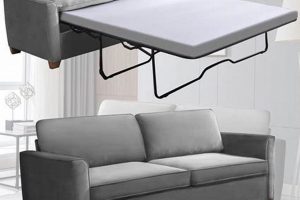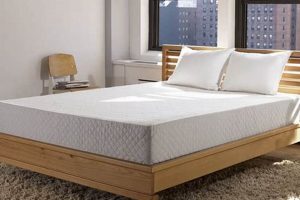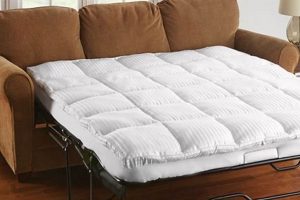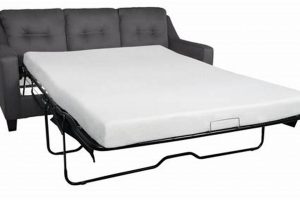The timeframe one should allow for a newly unboxed Novaform mattress to fully expand and off-gas before use is a common consideration for new owners. This waiting period is dictated by the mattress’s construction, particularly the type and density of foam used, and the manufacturing processes involved. A typical range for this initial settling is between 24 and 72 hours, allowing the compressed materials to reach their intended shape and for volatile organic compounds (VOCs) to dissipate.
Allowing sufficient time for this process provides several benefits. Primarily, it ensures the mattress delivers its intended level of comfort and support, preventing premature sagging or unevenness. Furthermore, off-gassing VOCs can cause temporary odors, and adequate ventilation during the expansion period minimizes potential discomfort. The evolution of mattress manufacturing has gradually reduced off-gassing, but a waiting period remains standard practice for optimal performance and user experience.
Consequently, understanding the factors influencing this recommended waiting period and knowing how to expedite the process, as well as acknowledging potential indicators that the mattress is ready for use, are important aspects when acquiring a new Novaform mattress. Proper preparation enables users to maximize the lifespan and comfort benefits of their purchase.
Optimal Usage Preparation
Maximizing the comfort and longevity of a new Novaform mattress requires adherence to several key practices following unboxing.
Tip 1: Unboxing Location: Designate a well-ventilated room for the initial unboxing and expansion. This accelerates off-gassing and minimizes any potential odors.
Tip 2: Prompt Unboxing: Remove the mattress from its packaging as soon as it arrives. Prolonged compression can hinder complete expansion.
Tip 3: Observe Expansion: Monitor the mattress’s expansion progress over the initial 24 hours. This provides an indication of its readiness for use.
Tip 4: Rotate and Flip (if applicable): Certain Novaform models benefit from rotation or flipping (if designed to be two-sided) after the initial expansion to ensure even wear.
Tip 5: Use a Mattress Protector: Protecting the mattress with a breathable mattress protector safeguards against spills and stains, extending its lifespan.
Tip 6: Allow Adequate Ventilation: Continued ventilation during the first week is beneficial to further reduce any residual odors from the manufacturing process.
Tip 7: Consult Manufacturer Guidelines: Refer to the specific instructions provided by Novaform for its products. These guidelines address the specifics of a particular model.
Adhering to these recommendations helps ensure the mattress reaches its full potential for comfort and support, optimizing the sleep experience.
Following these preparatory steps sets the foundation for long-term satisfaction with the new Novaform mattress.
1. Full Expansion
Full expansion represents a critical stage in the setup of a newly unboxed Novaform mattress, directly influencing the recommended waiting period prior to its first use. Incomplete expansion can compromise support and comfort, thus understanding its components is essential.
- Cellular Structure Development
Foam mattresses, particularly memory foam and latex variants, consist of intricate cellular structures. Compression during packaging distorts these structures. Full expansion allows these cells to return to their designed shape and volume, contributing to the mattress’s overall firmness and conformity. Sleeping on a mattress before complete cellular development can lead to uneven wear and diminished support over time.
- Dimensional Integrity
A mattress advertised as 12 inches thick should achieve that height upon full expansion. Premature use prevents the internal materials from fully occupying the available space, resulting in a thinner, less supportive sleeping surface. This discrepancy can lead to discomfort and potentially affect spinal alignment. Accurate measurement of mattress dimensions after the recommended waiting period confirms complete expansion.
- Support Layer Activation
Multi-layered foam mattresses rely on each layer contributing to the overall support system. Full expansion ensures that each layer from the base support foam to the comfort layers reaches its intended density and firmness. If the support layers are not fully expanded, the mattress may feel too soft or lack the necessary reinforcement for proper spinal alignment. A discernible difference in firmness before and after the waiting period indicates support layer activation.
- Edge Support Formation
Edge support, often achieved through denser foam around the perimeter of the mattress, prevents sagging when sitting or sleeping near the edge. Full expansion is necessary for these edge support components to fully engage and provide the intended level of stability. Premature use can cause premature breakdown of the edge support, reducing the usable sleep surface and potentially shortening the mattress’s lifespan.
Achieving full expansion is therefore not merely a cosmetic consideration; it is fundamental to the mattress’s ability to deliver the promised comfort, support, and durability. The “how long to wait before sleeping on new novaform mattress” recommendation directly correlates with the time required for the internal materials to achieve their designed state and ensure long-term performance.
2. Off-gassing Duration
Off-gassing duration is a primary determinant in how long to wait before sleeping on a new Novaform mattress. This process involves the release of volatile organic compounds (VOCs) trapped within the foam during manufacturing. While generally harmless in low concentrations, these compounds can produce noticeable odors and, in sensitive individuals, potentially trigger adverse reactions. Therefore, adequate ventilation and waiting time are essential for mitigating potential issues.
- VOC Composition and Concentration
The specific compounds and their concentration influence the intensity and duration of off-gassing. Certain foams and adhesives release higher levels of VOCs than others. Mattress manufacturers often use CertiPUR-US certified foams, which have undergone testing to ensure low VOC emissions. However, even certified materials require time to dissipate residual odors. The initial concentration of VOCs directly correlates with the recommended waiting period; higher concentrations necessitate longer ventilation before use.
- Environmental Factors
Ambient temperature and humidity levels significantly impact the rate of off-gassing. Higher temperatures accelerate the release of VOCs, while adequate ventilation aids in their dispersion. A poorly ventilated room prolongs the process and may intensify odors. Conversely, placing the mattress in a well-ventilated area, such as near an open window, facilitates faster dissipation. Environmental conditions should be considered when determining the appropriate waiting time, especially in enclosed spaces.
- Odor Sensitivity
Individual sensitivity to odors varies considerably. Some individuals may not perceive any noticeable smell, while others may experience discomfort or even allergic reactions. Those with heightened olfactory senses or pre-existing respiratory conditions may require a longer waiting period to ensure minimal exposure to VOCs. Personal sensitivity levels should guide the decision-making process when determining when the mattress is suitable for use.
- Duration of off-gassing with different types of foam.
The amount of time you need to wait before sleeping on a new foam mattress varies depending on the kind of foam used. Here is a general estimate:
- Polyurethane foam: needs 24 to 72 hours
- Memory foam: needs 24 to 72 hours
- Latex foam: needs a few days to a week
- Manufacturer Recommendations and Certifications
Mattress manufacturers typically provide guidelines regarding the recommended waiting period based on their specific materials and processes. Certifications, such as CertiPUR-US, offer assurance regarding low VOC emissions but do not eliminate the need for ventilation. Adhering to manufacturer recommendations and considering certifications provides a baseline for determining the appropriate waiting time.
In summary, the off-gassing duration directly influences the timeline for safely and comfortably using a new Novaform mattress. Understanding the interplay of VOC composition, environmental factors, individual sensitivity, and manufacturer recommendations enables informed decisions regarding the optimal waiting period, mitigating potential health concerns and maximizing sleep quality.
3. Foam Density
Foam density plays a significant role in determining the appropriate waiting period before sleeping on a new Novaform mattress. Higher-density foams, characterized by a greater mass of material per unit volume, generally require a longer timeframe for complete expansion and off-gassing compared to lower-density foams. This correlation stems from several key factors related to the material’s inherent properties.
- Compression Rate and Rebound
Higher-density foams are typically more compressed during the manufacturing and packaging processes. As a result, the cellular structure within the foam requires more time to fully rebound and achieve its intended shape and support characteristics. This slower rebound contributes to an extended waiting period, as the mattress needs adequate time to attain its designated thickness and firmness. Rushing this process can lead to uneven support and premature sagging.
- Off-Gassing Capacity
Higher-density foams tend to retain a greater volume of volatile organic compounds (VOCs) due to their increased material content. Consequently, the off-gassing process, during which these compounds dissipate, is prolonged compared to lower-density foams. Insufficient ventilation during this period can result in lingering odors and potential discomfort for sensitive individuals. Allowing adequate time for off-gassing mitigates these risks and ensures a more pleasant sleep environment.
- Heat Retention
Denser foams inherently possess greater heat retention properties. This characteristic can impact the rate of expansion and off-gassing, particularly in cooler environments. The increased thermal mass requires more time to reach equilibrium with the surrounding air, potentially slowing down the expansion process. Ensuring proper ventilation and maintaining a moderate room temperature can help to expedite the process and reduce the overall waiting period.
- Structural Integrity and Longevity
While higher-density foams often offer enhanced durability and support, premature use before full expansion can compromise their long-term structural integrity. Forcing the mattress into use before the internal materials have fully settled can lead to uneven stress distribution and accelerated wear. Adhering to the recommended waiting period allows the foam to fully stabilize, maximizing its lifespan and maintaining its intended performance characteristics.
In conclusion, foam density directly influences the expansion rate, off-gassing duration, and overall performance of a new Novaform mattress. Understanding the relationship between these factors allows for a more informed decision regarding the appropriate waiting period, ultimately contributing to enhanced comfort, support, and longevity of the sleep surface.
4. Ambient Temperature
Ambient temperature exerts a demonstrable influence on the expansion rate and off-gassing process of newly unboxed Novaform mattresses, thereby directly affecting the recommended waiting period before use. Lower temperatures impede the expansion of the compressed foam, increasing the time required for it to achieve its designated dimensions and firmness. Conversely, elevated temperatures accelerate expansion and the release of volatile organic compounds (VOCs), potentially shortening the necessary waiting time. However, excessively high temperatures may also alter the foam’s structural integrity, necessitating a cautious approach.
The practical implications of ambient temperature are significant. A mattress unboxed in a cold storage unit during winter, for example, will necessitate a longer acclimatization period within a temperature-controlled room before achieving optimal expansion and minimal odor. Conversely, a mattress unboxed during a hot summer day in a well-ventilated space may exhibit a more rapid expansion and off-gassing process. In the latter scenario, care must still be taken to ensure the mattress does not overheat, as this could compromise its structure. Real-world scenarios highlight the need for informed adjustment of the waiting period based on prevalent environmental conditions.
Therefore, understanding the role of ambient temperature is critical for optimizing the setup process of a Novaform mattress. The suggested waiting period provided by the manufacturer serves as a general guideline, but it should be adapted to reflect the actual temperature of the environment in which the mattress is expanding. This adaptive approach allows for a more efficient and effective setup, ensuring the mattress achieves its full potential in terms of comfort, support, and odor mitigation, without compromising its structural integrity or prolonging the waiting time unnecessarily.
5. Ventilation effectiveness
Ventilation effectiveness directly dictates the timeframe one must adhere to before using a new Novaform mattress. Inadequate ventilation prolongs the off-gassing process, extending the duration before the mattress is deemed suitable for sleep. The release of volatile organic compounds (VOCs) is a natural consequence of the manufacturing process, and their dissipation relies heavily on sufficient airflow. A confined space with limited air exchange will trap these compounds, resulting in lingering odors and potential discomfort or health concerns for sensitive individuals. Thus, maximizing ventilation is a key factor in minimizing the waiting period.
A real-world example illustrates the impact of ventilation. Consider two identical Novaform mattresses unboxed simultaneously. One is placed in a small, windowless room, while the other is positioned in a larger, well-ventilated area with open windows and a circulating fan. The mattress in the confined space will exhibit a significantly longer off-gassing period, potentially requiring several days before the odor dissipates sufficiently. Conversely, the mattress exposed to ample ventilation will likely be ready for use within the manufacturer’s recommended timeframe, or even sooner. This demonstrates the practical significance of ventilation as a means of expediting the preparation process.
Effective ventilation facilitates the removal of VOCs, accelerating the reduction of odors and promoting a healthier sleep environment. However, ventilation is not a solitary solution. Other factors, such as ambient temperature and individual sensitivity to odors, also contribute to the overall timeframe. Ultimately, the optimal waiting period is a product of these factors, with ventilation effectiveness playing a critical role in achieving a balance between preparation time and user comfort. Addressing challenges related to poor ventilation, such as utilizing air purifiers or improving airflow through natural or mechanical means, contributes to a more efficient and comfortable mattress setup experience.
6. Odor dissipation
Odor dissipation serves as a primary indicator of a new Novaform mattress’s readiness for use, directly correlating with the “how long to wait before sleeping on new novaform mattress” recommendation. The characteristic “new mattress” odor arises from volatile organic compounds (VOCs) released from the foam during manufacturing and packaging. These VOCs, while generally present in low concentrations and considered non-toxic by regulatory standards, can be perceived as unpleasant and may cause discomfort or sensitivity reactions in some individuals. The rate and completeness of odor dissipation, therefore, determine the length of the waiting period, with complete or near-complete dissipation signaling the mattress is ready for optimal comfort.
Consider a scenario where two identical Novaform mattresses are unboxed simultaneously. One is left in a well-ventilated room with open windows, while the other remains in a closed, poorly ventilated space. The mattress in the well-ventilated room will exhibit a significantly faster rate of odor dissipation. The timeframe before the odor becomes unnoticeable, or falls below a threshold deemed acceptable by the user, dictates when that mattress is suitable for sleep. Conversely, the mattress in the poorly ventilated room may require days or even weeks for the odor to dissipate to the same level, correspondingly extending the waiting period. This exemplifies the direct causal relationship between odor dissipation and the determination of when to use the new mattress.
The effectiveness of odor dissipation hinges on multiple factors, including the specific foam composition, manufacturing processes, ambient temperature, and ventilation. While manufacturers take steps to minimize VOC emissions, some degree of off-gassing is unavoidable. In practice, assessing odor dissipation involves periodically checking the mattress for residual odors. Once the odor has diminished to a tolerable level, the waiting period can be considered complete. It is crucial to note that the perception of odor is subjective, and individual sensitivities will vary. Prioritizing sufficient odor dissipation and tailoring the waiting period accordingly enhances the overall sleep experience and addresses potential health concerns. Thus, understanding the intricacies of odor dissipation is a fundamental element in determining the appropriate timeframe before sleeping on a new Novaform mattress.
7. Comfort preference
Subjective comfort significantly influences the perceived readiness of a new Novaform mattress, and therefore, impacts the timeframe before one chooses to sleep on it. While manufacturers provide general guidelines, individual preferences regarding firmness, odor sensitivity, and overall feel ultimately dictate the appropriate waiting period. Comfort is not a static metric; rather, it is a personal assessment that evolves as the mattress expands and off-gasses.
- Firmness Perception
A primary element of comfort is the perceived firmness of the mattress. Individuals accustomed to a firmer sleeping surface may find a newly unboxed mattress initially too soft, even after the manufacturer’s recommended expansion period. This perceived softness may diminish over time as the foam fully settles and reaches its intended density. The waiting period, therefore, extends until the mattress aligns with the individual’s preferred firmness level. A person accustomed to a plush mattress might find it comfortable much sooner than someone who prefers very firm support. This subjective evaluation takes precedence over generalized recommendations.
- Odor Sensitivity and Respiratory Considerations
Sensitivity to the off-gassing odors, common in new foam mattresses, is a significant determinant of comfort. Individuals with heightened olfactory senses or respiratory conditions, such as asthma, may find the initial odors intolerable, even at low concentrations. The waiting period must extend until these odors dissipate to a level deemed acceptable by the individual, often requiring enhanced ventilation and potentially exceeding the manufacturer’s guidelines. Failure to address odor sensitivity can compromise sleep quality and potentially trigger adverse health reactions.
- Support and Alignment Preferences
Comfort is inextricably linked to proper spinal alignment and adequate support. Individuals with specific musculoskeletal conditions or sleep preferences may require a longer adjustment period to assess whether the mattress provides the necessary support. This period allows them to determine if the mattress alleviates pressure points and promotes a comfortable sleep posture. Prematurely using the mattress without adequate assessment can exacerbate existing conditions or lead to new discomforts, ultimately undermining the goal of improved sleep quality.
- Tactile Sensations and Material Preferences
The feel of the mattress surface, including its texture and breathability, contributes significantly to overall comfort. Individuals may have preferences for specific materials, such as memory foam, latex, or hybrid constructions. The waiting period provides an opportunity to evaluate these tactile sensations and ensure they align with personal preferences. Additionally, it allows individuals to assess the mattress’s breathability and temperature regulation capabilities, factors that can greatly impact sleep comfort. A waiting period that accounts for tactile and material preferences ensures greater satisfaction.
In essence, while expansion and off-gassing dictate the minimum waiting period for a new Novaform mattress, individual comfort preferences ultimately govern the optimal timeframe. Factors such as firmness perception, odor sensitivity, support needs, and tactile sensations must be carefully considered to ensure a sleep experience that aligns with personal requirements and promotes long-term satisfaction. Disregarding comfort preferences in favor of adhering strictly to manufacturer guidelines can lead to suboptimal sleep quality and potential discomfort.
Frequently Asked Questions
This section addresses common inquiries regarding the optimal waiting period before using a new Novaform mattress. These answers provide insights into maximizing mattress performance and user satisfaction.
Question 1: What is the standard recommended waiting period?
The standard recommendation typically ranges from 24 to 72 hours. This timeframe allows for complete expansion and the dissipation of volatile organic compounds (VOCs).
Question 2: What factors influence the duration of the waiting period?
Several factors play a role, including foam density, ambient temperature, ventilation effectiveness, and individual sensitivity to odors. Higher density foams and colder temperatures may necessitate a longer waiting period.
Question 3: Is it harmful to sleep on the mattress before the recommended waiting period?
While not acutely harmful, premature use can compromise the mattress’s ability to fully expand, potentially affecting its support and longevity. Furthermore, some individuals may experience discomfort from off-gassing odors.
Question 4: How can the expansion and off-gassing process be expedited?
Ensuring adequate ventilation by opening windows and using fans can accelerate the dissipation of VOCs. Maintaining a moderate room temperature also aids in the expansion process.
Question 5: How does foam density influence the waiting period?
Higher-density foams generally require a longer waiting period due to their increased mass, which retains more VOCs and requires more time for complete expansion.
Question 6: Will the “new mattress” odor completely disappear?
The intensity of the odor should diminish significantly after the recommended waiting period. However, trace amounts may persist for several weeks, depending on the specific foam composition and environmental conditions.
In summary, while manufacturer guidelines provide a baseline, the ultimate determination of when to use a new Novaform mattress depends on a comprehensive assessment of expansion, odor dissipation, and individual comfort preferences.
The subsequent section will explore troubleshooting potential issues that may arise during the mattress setup process.
Determining Optimal Usage Time
The exploration has shown that “how long to wait before sleeping on new novaform mattress” is governed by multiple, interacting factors. These encompass the degree of full expansion, the duration of off-gassing, the foam density of the mattress, ambient temperature, effectiveness of ventilation, dissipation of odors, and personal preferences pertaining to comfort. These factors need to be considered to arrive at the decision about usage time.
Given the interplay of elements impacting the period before using a new Novaform mattress, careful consideration of specific conditions and tolerances ensures both maximized comfort and durability, as well as a minimization of potential adverse reactions. Prudent implementation of these guidelines will enable users to realize the full benefit of their purchase, facilitating the delivery of years of optimal sleep quality.







